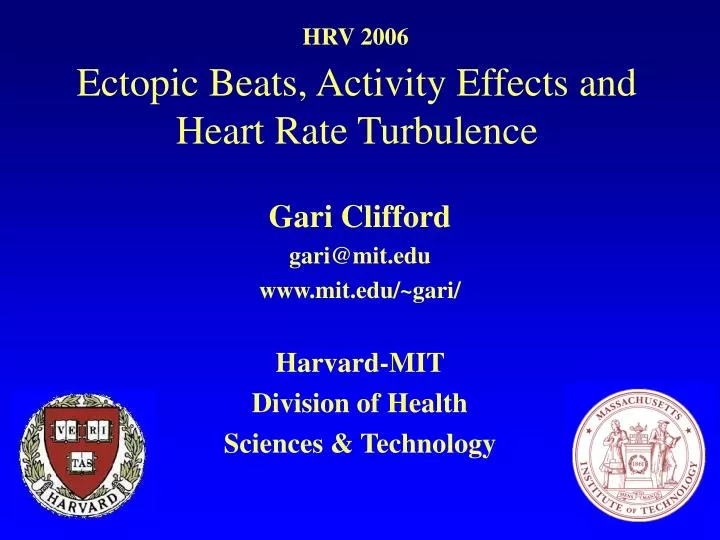
190 likes | 483 Views
HRV 2006. Ectopic Beats, Activity Effects and Heart Rate Turbulence. Gari Clifford gari@mit.edu www.mit.edu/~gari/ Harvard-MIT Division of Health Sciences & Technology. Outline. Overview of Cardiovascular Nonstationarity Activity/Sleep-Wake Effects Ectopy HR Turbulence

E N D
HRV 2006 Ectopic Beats, Activity Effects and Heart Rate Turbulence Gari Clifford gari@mit.edu www.mit.edu/~gari/ Harvard-MIT Division of Health Sciences & Technology
Outline • Overview of Cardiovascular Nonstationarity • Activity/Sleep-Wake Effects • Ectopy • HR Turbulence • QT Turbulence
Overview: Dealing with Discontinuities • RR tachogram unevenly sampled - Resampling introduces errors. • Spectral methods assume linear, stationary processes • RR tachogram is nonstationary; ectopy, artefact or intrinsic cardiovascular changes • HRV is a function of both physical and mental activity • Artefacts and ectopy can be removed, but this is also information • Artefact is an indicator of state change • Ectopy affects the RR tachogram – Heart Rate Turbulence
Cardiovascular Nonstationarity HRi • Tachogram has many states with similar means or variances • Length of state varies minutes • (weakly stationary) • Movements between states have brief accelerations in RR interval new mean and/or variance. Time (40 mins) • Don’t apply HRV methods blindly - Must control for state!
HRV depends on activity Awake Deep Sleep • HRV changes significantly in different sleep states Light Sleep Dream Sleep • Control for state when applying HRV methods! • Control for state when applying HRV methods! • Adapted from:Otzenberger et al.Dynamic heart rate variability: a tool for exploring sympathovagal balance … in sleep Am J Physiol Heart Circ Physiol 275: H946-H950, 1998.
Changes due to ectopy Data courtesy of PhysioNet; http://www.physionet.org
Heart Rate Turbulence • SA node response to ectopic beat; short HR acceleration then deceleration. • Maintain BP; rapid parasympathetic withdrawal? • Then parasympathetic innervation baseline http://www.h-r-t.org/hrt/en/hrtdemo_js.html Credit: R. Schneider: http://www.librasch.org/
Heart Rate Turbulence • Ectopic beats disturb RR tachogram stationarity • Disturbance lasts 10 - 20 beats • HRT quantifies this disturbance using 2 metrics: • TO: Turbulence Onset • TS: Turbulence Slope
TS/TO: Turbulence Onset/Slope Credit: Bauer A, Barthel P, Schneider R, Schmidt G. Dynamics of Heart Rate Turbulence. Circulation 2001b; Vol. 104; No. 17; Supplement; II-339, 1622.
Turbulence Onset (+ index intervals after ectopic, - index before) Percentage difference between mean of each pair of NN intervals on either side of ectopic pair Must average the TO over >> 10 ectopics
TS: Turbulence Slope Find steepest slope for each possible sequence of 5 consecutive normal intervals from RR+2 RR+16 Usually average 10-20 time series first then calculate one TS on the average time series! Outlier Rejection Important: (See Notes) Clifford, G.D., “ECG Statistics, Noise, Artefacts and Missing Data”, Chapter 3 in Advanced methods and tools for ECG data Analysis, Clifford,et al(Eds), Artech House,2006.
Examples Run: http://www.librasch.org/hrt/en/hrtdemo_java.html Figure Credit: Mäkikallio et al., Eur. Heart J., April 2005; 26:
Normal Response TO > 0 and TS > 2.5 are normal (a healthy response to PVCs is a strong sinus acceleration followed by a rapid deceleration) • An independent predictor of late mortality after acute MI [Schmidt 1999, Ghuran 2002, Wichterle 2004, Watanabe 2005, Baur 2006] • Abnormal HRT Predicts Initiation of Ventricular Arrhythmias [Iwasa 2005] • HRT indices appear to correlate better with EF than SDNN inChagas disease [Tundo2005] • HRT Predicts Cardiac Death in Patients Undergoing CABG [Cygankiewicz 2003] • Prognostic Marker in Patients with Chronic Heart Failure [Kayama 2002] • Risk Predictors in Patients With Diabetes Mellitus [Barthel 2002] • Decreased HRT in patients with diabetes mellitus [Barthel 2000]
Nonstationarity Example: QT Hysteresis • QTc = QT/RRn • n = ½,⅓ • QT is HR-dependent • QT interval = depolarization + repolarization • QTc: marker of arrhythmias & potentialpredictor of mortality
QT turbulence • -QT-interval turbulence occurs in association with • HRT following induced ventricular or atrial ectopy • Replace NN intervals by QT intervals • QT TO but not TS reported to be useful (so far) • Other metrics exist; It’s a nascent field • Patients with ischemic VT and LV dysfunction • exhibited significantly lower QT TO values than those • with nonischemic VT and normal LV function. Savelieva,I., Wichterle,D., and Camm, J.A., QT-Interval Turbulence Induced by Atrial and Ventricular Extrastimuli in Patients with Ventricular Tachycardia, PACE, 28, s1, S187-S192, 2005,
Recap / Conclusions • Nonstationarities important both as confounders and information conveyors • Don’t just ignore/remove them • HRT is interesting approach to extracting information from very short nonstationary segments of data • Acknowledgements: Many, many thanks to Raphael Schneider! • See www.h-r-t.org for more information and software.
